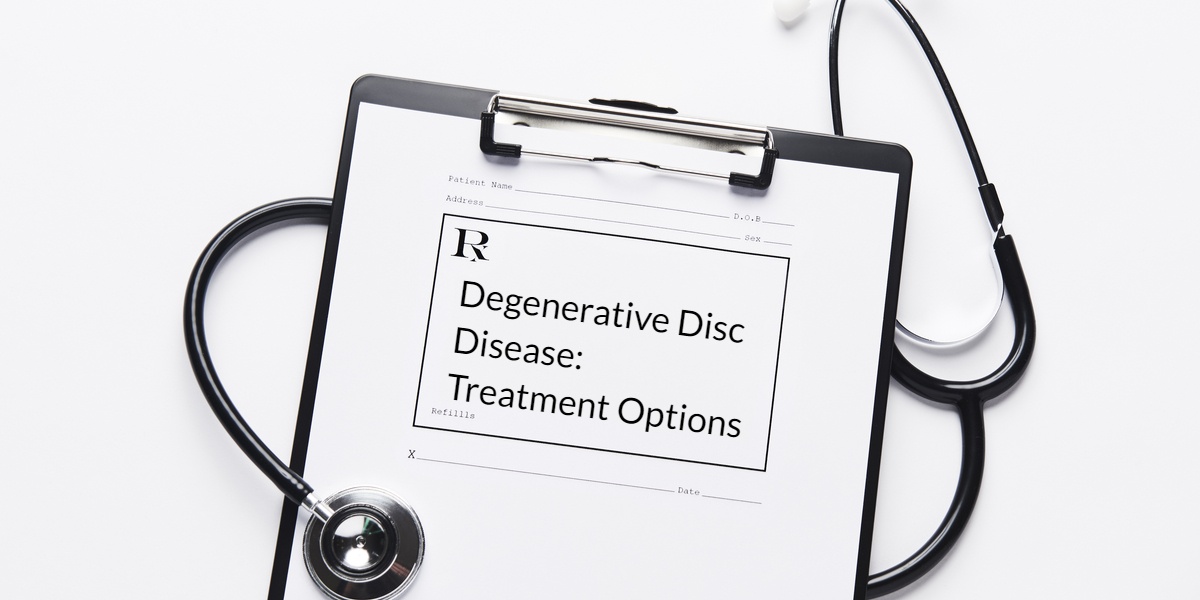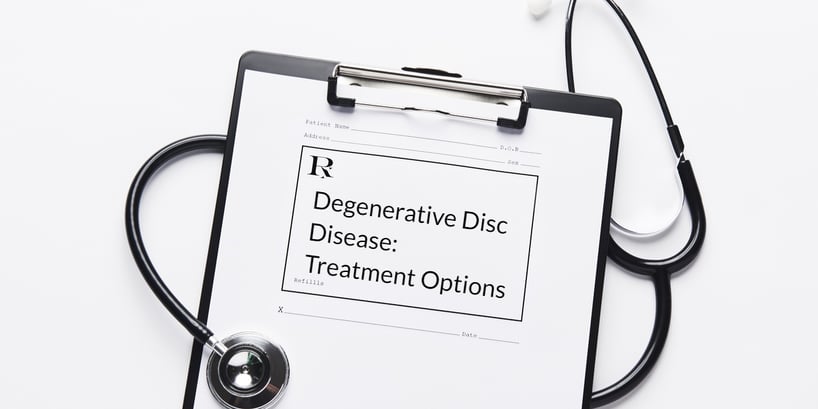DEGENERATIVE DISC DISEASE: TREATMENT OPTIONS
June 30th, 2017 | 5 min. read


Degenerative disc disease (DDD) is a medical term used to describe the gradual, natural breakdown of intervertebral discs separating the bones of the spine. These gel-like “shock absorbers” provide a cushion between the vertebrae and give the spine its flexibility and mobility.
When the fluid-filled discs begin to wear away as you approach or pass the age of 40, you may find yourself experiencing symptoms or side effects like neck and lower back pain, herniated discs, osteoarthritis, spinal stenosis, or nerve impingement, inflammation, or damage. Some of these conditions are merely annoying, whereas others may affect your function, causing tingling or loss of feeling in the hands or feet.
Who Gets Disc Degeneration?
Eventually, some degree of disc degeneration will happen to most of us. According to The Arthritis Foundation, nearly everyone over the age of 60 has some form of degeneration of the spine.
Certain inherited conditions, lifestyle factors (like obesity), and traumatic incidents may bring about an earlier onset of degeneration (or a greater severity), but sooner or later most adults will experience this condition.
However, the fact that degenerative disc disease is inevitable doesn’t mean you can’t treat its symptoms and find some relief. Most people with DDD (and most physicians) would prefer to treat it conservatively, with lifestyle changes, self-care, exercise, and physical therapy. If these measures don’t help to ease pain and improve flexibility, you may need to see a specialist to discuss manipulation of the spine, medications, injections, or even surgery.
The following treatments are those most commonly recommended to people with DDD.
Self-Care/Pain Management
The most conservative way to treat lumbar pain or neck pain due to DDD is to use non-surgical, non-medicinal techniques or modalities. These include:
- Heat therapy. Heat therapy, especially moist heat (such as the heat from a warm bath, Jacuzzi, or hot tub), can promote blood flow to the spine, relax tense or spasming muscles, and promote relaxation. A hot water bottle or heat pack on the back or neck can also help with pain.
- Lower back disc degeneration in particular responds well to weight loss and exercise. Building up your core muscles (abdominals and back muscles) through a core training program can help to stabilize and strengthen your back, taking the pressure off damaged discs. Examples of good core-strengthening workouts include yoga, Pilates, swimming, light weight training or resistance training, balance ball work, and holding the plank position (keeping your torso, buttocks, and legs off the floor—and parallel to it—by supporting your weight on your forearms and toes).
- Psychological coping tools. Relaxation techniques like cognitive behavioral therapy, meditation, and visualization have been shown to help people manage chronic pain. By learning to direct your attention away from your pain, you may be able to dial down your pain signals—or at least decrease the amount of anxiety you experience in response to your discomfort.
- Restorative sleep promotes healing and helps you to remain calm when you’re under stress (and we all know, pain can be stressful). Unfortunately, back pain can make restful sleep difficult. If you’re having trouble sleeping due to back or neck soreness, you may need to simultaneously treat both the sleep issues and the spinal pain. Seeing a sleep specialist may help.
- Behavioral change. This advice may seem like common sense, but it works: avoid or modify the activities or body positions that trigger your pain. Instead of sitting, try standing, kneeling, or using a special ergonomic chair that shifts your weight away from your lower back. Instead of lifting objects by bending at the waist, try squatting to get closer to the ground. If turning your head to see what’s behind you hurts, use mirrors, a backup camera, or your passengers to help you check behind you when driving.
Medical Devices
Certain medical support devices, either purchased from a pharmacy or prescribed by a physician, may help to ease the tension and physical forces that act on your spine.
Generally, supports such as braces should be worn for short durations only. Long-term use of a brace or collar may immobilize your spine for too long, restricting movement and leading to a weakening, shortening, or atrophying of your muscles (which will inevitably lead to more pain and dysfunction).
Such devices can include:
- Cervical spine collar. If the affected disc is in the neck, a collar may help to support the cervical spine and reduce forces on the affected disc.
- Corset brace. If the affected disc is in the lower back, a back brace may reduce weight bearing on your affected lumbar disc.
Physical Therapy
PT and some of the specific therapeutic modalities offered by physical therapists (and some orthopedic practices) is another option for managing pain and improving range of motion. Some PT strategies that may be effective include:
- Stretching and strengthening. As with exercise, stretching and strengthening your core or neck can help to balance your body, correct posture problems, and strengthen weak muscles.
- Electrical stimulation, or e-stim, uses a small amount of electric signal to override pain signals. Some people with back pain report that e-stim helps them to minimize their pain, move better, and take a lower-strength pain medication.
- Spinal traction, as a decompression therapy, may help with pain by relieving some of the pressure on compressed intervertebral discs. Therapists can perform traction either manually (with their hands) or mechanically (with a device). Traction is low risk, but it doesn’t work for all back pain.
Chiropractic and Osteopathic Manipulation or Massage
Some people with chronic back and neck pain from DDD get relief from manual manipulation by a chiropractor, osteopath, or massage therapist. Manipulation of the spine and surrounding tissue may help to take some of the pressure off nerves (for example, a chiropractic manipulation may help relieve sciatica symptoms).
Massage and manipulation may also help to:
- increase range of motion
- stimulate blood flow (and therefore heal damaged tissue)
- release muscle tension and relieve cramps and spasms
- relieve pain
These techniques can help with symptom management, but they are temporary and usually need to be repeated regularly.
Medication
- NSAIDs (non-steroidal anti-inflammatory drugs, like ibuprofen and naproxen) can help to reduce inflammation and pain. You can acquire these over-the-counter or your doctor may prescribe you a stronger dose. NSAIDs should not be taken daily over the long term, as they can cause gastrointestinal problems and bleeding or bruising.
- Prescription pain relievers or relaxants. If your pain is severe and disabling, prescription drugs such as narcotics or muscle relaxants may help. However, using medication long-term carries a risk of dependency. Also, for some people, medication may conflict with other prescription drugs they may be taking.
Steroid Injections by a Doctor
If your pain is non-responsive to these methods, or if you’re in so much agony you can’t begin an exercise program, epidural steroid injections (with or without anesthetic) into the area round your facet joints may help.
An estimated half (50%) of patients who receive corticosteroid injections report significant relief of their pain symptoms.
Steroid injections are not a first-line approach. They’re not guaranteed to work and they can not be repeated often because shots administered to the same location over time can promote bleeding and bruising. Steroids can also have a negative effect on surrounding tissue. Doctors advise no more than three injections per year.
Surgery
The last resort for many people is a surgery—in part because many people with disc degeneration are older and are hesitant to undergo unnecessary surgical procedures. However, today’s minimally invasive spinal surgeries are largely very safe.
Back or neck surgeries for disc degeneration include the following.
Spinal fusion. If your damage is significant, spinal fusion surgery can use screws and rods, and sometimes a bone graft, to fuse or join two or more damaged vertebrae. Fusion can add stability to a weakened back, allowing it to bear your weight without issue. It usually resolves pain issues, but it can leave you with less flexibility in that part of the spine. However, it’s a highly successful surgery and it can heal even more quickly with the additional of bone growth stimulator treatments, which are commonly recommended following the procedure.
Disc decompression surgeries. The type of decompression surgery your orthopedist recommends depends on what type of disc damage you’ve sustained and how it’s affected surrounding nerves and tissue. Some commonly performed cervical or lumbar decompression surgeries include:
- laminectomy or laminotomy (to remove parts of, or all of, the “roof” of a vertebra, making more space for the spinal cord)
- foraminotomy (to widen the foramina, or hole, that nerves pass through)
- discectomy (to remove damaged discs)
Disc replacement surgeries. Artificial discs are now available to fully replace a damaged disc. While the procedure is relatively new and there are yet no long-term studies available, artificial disc replacement promises to retain more flexibility and motion over traditional procedures like spinal fusion.
Contact Coastal Orthopedics today with any questions about your diagnosis or treatment options for Degenerative Disc Disease at (361) 994-1166.
Article written by: Rob Williams, MD
Dr. Williams has been practicing orthopedic surgery in Corpus Christi since 1998. After graduating from Texas Tech hereceived his medical degree from the University of Texas at San Antonio. At the prestigious Campbell Clinic located at the University of Tennessee, Dr. Williams completed not only an Orthopedic Surgery Residency, but an additional year of Fellowship Training in Spine Surgery. Dr. Williams is dedicated to creating an excellent patient experience in the office or in the surgery suite.
Topics:

